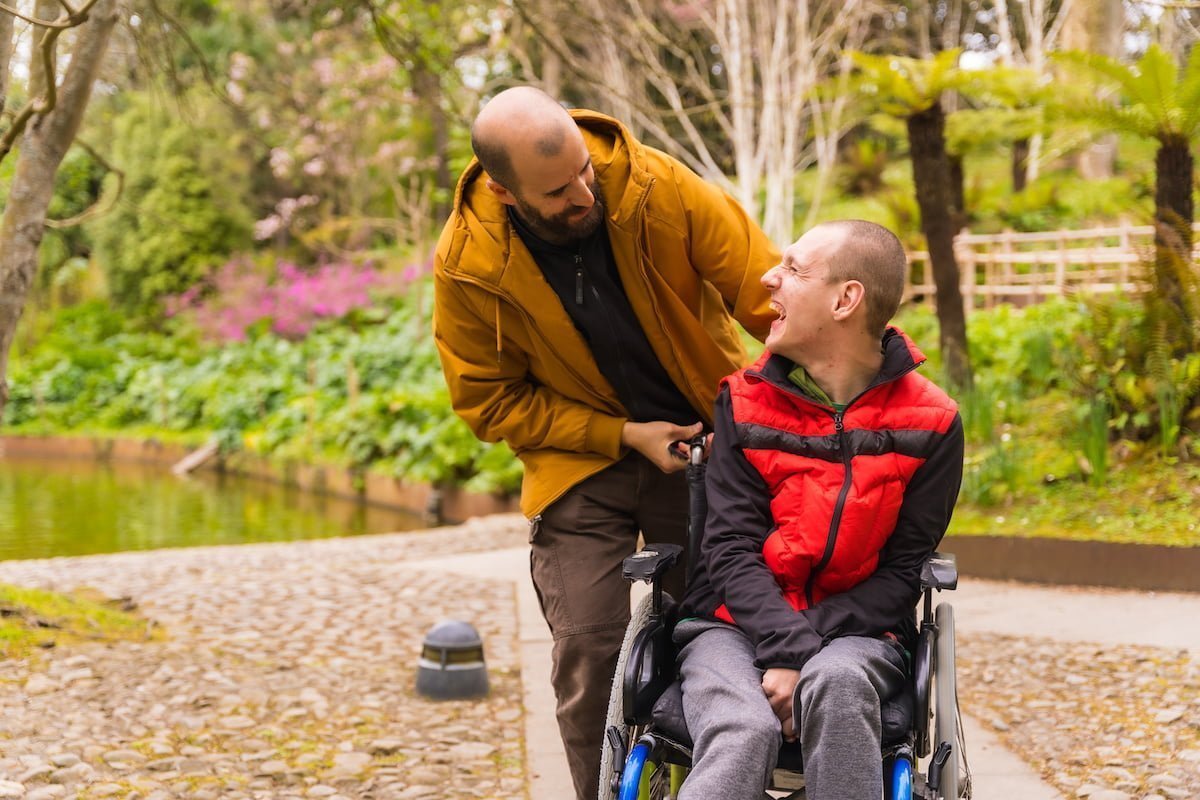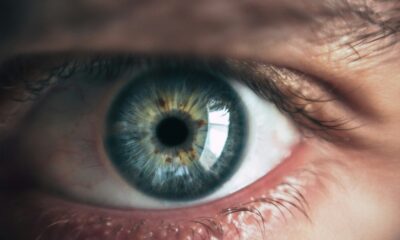Experts examine how Medical Cannabis may have the potential to improve the quality of life for individuals with Muscular Dystrophy.
The article is an excerpt from Cannabiscientia’s handbook, Principles of Clinical Cannabinology, by Viola Brugnatelli and Fabio Turco.
Muscular dystrophy (MD) brings a unique set of challenges. Chronic pain, muscle spasms, and limitations in daily life can be debilitating. While there’s no cure for MD, new treatments for symptom management are emerging.
This article explores how cannabis may alleviate pain and muscle spasticity, discuss ongoing research, and address the limitations of current knowledge.
Understanding Muscular Dystrophy
Muscular dystrophy (MD) encompasses a group of hereditary conditions characterized by progressive muscle degeneration and weakness. This debilitating condition significantly impacts the quality of life, causing pervasive muscle weakness and difficulty performing everyday movements. The firs report of MD dates back to 1836, when Italian doctors Gaetano Conte and Luigi Gioja described cases of progressive muscle weakness in two brothers. However, this case was initially misinterpreted as tuberculosis by their contemporaries due to limited medical knowledge and diagnostic tools at the time. [1]
It wasn’t until 1861 that French neurologist Guillaume Duchenne recognized it as a distinct disease, later known as Duchenne muscular dystrophy. Duchenne’s meticulous documentation helped differentiate muscular dystrophy from other neuromuscular disorders. [2] By 1868, Duchenne had described multiple cases and published detailed photographs, solidifying the understanding of this condition as a genuine disease.
Genetic Basis and Types of Muscular Dystrophy
Muscular dystrophies are primarily caused by genetic mutations that impair the production and function of crucial muscle proteins. These mutations lead to the deterioration of muscle fibers, resulting in muscle weakness and atrophy. The inheritance patterns of these mutations can be autosomal dominant, autosomal recessive, or X-linked, determining how the disease manifests and is passed on through generations. [3]
There are 9 main types of muscular dystrophy, each with unique characteristics and varying degrees of severity: [3;4]
- Duchenne Muscular Dystrophy
- DMD is the most common form of childhood muscular dystrophy, affecting approximately 1 in every 3,500 to 5,000 male births globally. It is caused by mutations in the dystrophin gene on the X chromosome, leading to a complete lack of dystrophin protein. This protein is crucial for maintaining muscle cell integrity. Symptoms, such as difficulty in running, jumping, and frequent falls, usually appear between ages 2 and 5. As the disease progresses, affected individuals often lose the ability to walk by their early teens and experience life-threatening complications by their 20s.
- Becker Muscular Dystrophy
- Similar to DMD but milder, BMD results from mutations in the same gene but allows for some functional dystrophin production. Symptoms, which include muscle weakness and cramps, typically appear later in childhood or adolescence and progress at a slower rate. Affected individuals might not require hospitalization until their 30s.
- Congenital Muscular Dystrophy
- CMD is present at birth or early infancy, characterized by general muscle weakness, joint stiffness, and spinal deformities. Some forms of CMD also involve brain abnormalities, leading to intellectual disabilities. CMD affects both males and females and presents with varying severity depending on the specific genetic mutations involved.
- Distal Muscular Dystrophy
- Distal muscular dystrophies primarily affect the muscles of the hands, forearms, feet, and calves. These disorders are caused by mutations in several different genes, leading to progressive muscle weakness and motor difficulties. Despite the muscle degeneration, these forms typically do not affect lifespan.
- Emery-Dreifuss Muscular Dystrophy
- This form of MD is characterized by muscle weakness, tendon contractures, and cardiomyopathy, arising from defects in proteins surrounding the cell nucleus. Symptoms include difficulty in bending the neck forward, raising the arms, and cardiac complications, which can lead to sudden death if not properly managed.
- Facioscapulohumeral Muscular Dystrophy
- FSHD is one of the most common forms of MD, affecting both males and females. It involves muscle weakness and wasting, particularly in the face, shoulders, and upper arms. Symptoms usually appear in adolescence or early adulthood. Although debilitating, FSHD does not typically affect lifespan.
- Limb-Girdle Muscular Dystrophy
- Limb-Girdle MD affects the muscles around the hips and shoulders. It includes a variety of rare diseases caused by mutations in different genes. Symptoms, such as frequent falls and difficulty climbing stairs, often appear in adolescence or early adulthood and progressively worsen over time.
- Myotonic Muscular Dystrophy
- This form is characterized by myotonia, or prolonged muscle contractions, and is one of the most common adult-onset muscular dystrophies. It results from mutations on chromosome 19 or chromosome 3. Symptoms include difficulty swallowing, fatigue, cardiac issues, and cataracts. Onset typically occurs between ages 20 and 30.
- Oculo-pharyngeal Muscular Dystrophy
- This type primarily affects the muscles of the eyes and throat, leading to drooping eyelids and difficulty swallowing. It is caused by a genetic anomaly involving an abnormal repetition of the GCG triplet in the PABPN1 gene. This form of MD often appears in specific populations and usually manifests around age 60.
The Endocannabinoid System and Muscular Dystrophy
The Endocannabinoid System (ECS) is an intricate network of receptors and signaling molecules that play a vital role in regulating various physiological processes, including muscle function. The ECS includes cannabinoid receptors (CB1 and CB2), endocannabinoids like anandamide and 2-arachidonoyl glycerol (2-AG), and enzymes responsible for their synthesis and degradation.
CB1 receptors are predominantly found in the central nervous system, but they are also present in muscle tissue. These receptors help regulate muscle energy supply by influencing glucose and insulin metabolism. [5] During exercise and muscle development, ECS activity is altered, which may contribute to muscle growth and repair. Given this significant role, targeting the ECS presents a promising approach for managing muscular dystrophy symptoms.
READ MORE: Medical Cannabis in the Management of Glaucoma
Potential of Medical Cannabis for Muscular Dystrophy
The therapeutic potential of medical cannabis in managing muscular dystrophy symptoms is gaining attention due to several promising properties of cannabinoids. Research has highlighted the benefits of cannabinoids, such as tetrahydrocannabinol (THC), cannabidiol (CBD and cannabidivarin (CBDV), in alleviating chronic pain, reducing muscle spasms, and improving overall muscle function.
Studies on Duchenne Muscular Dystrophy
A study investigating Duchenne muscular dystrophy revealed altered expression patterns of the endocannabinoid 2-AG and increased CB1 receptor expression in the muscles of DMD patients and animal models compared to healthy controls. [6] This imbalance correlated with an increase in satellite cells, which are crucial for muscle repair but can be detrimental in excess. [7]
Treatment with rimonabant, a CB1 receptor antagonist, reduced satellite cell proliferation and improved muscle fiber health by enhancing myotube formation. In animal models, administering rimonabant prevented the loss of muscle coordination and strength, attributed to reduced inflammation and better muscle fiber integrity. [6]
Cannabidiol (CBD) and Cannabivarin (CBDV)
Cannabidiol (CBD) and its derivative Cannabivarin (CBDV) have garnered significant interest for their potential therapeutic effects on Duchenne muscular dystrophy. Studies have shown that both CBD and CBDV promote myotube formation in human muscle cells, essential for muscle growth and repair. In animal models of DMD, treatments with CBD and CBDV improved locomotor activity, reduced inflammation, and increased autophagy, a process that removes damaged cells and regenerates healthier cell. [8] While THCV (tetrahydrocannabivarin) did not show the same efficacy in promoting myotube formation, the benefits observed with CBD and CBDV suggest that these cannabinoids could play a crucial role in managing DMD symptoms and improving muscle function.
Cannabis Use in Myotonic Dystrophy
A pilot survey conducted in Germany and the United States explored cannabis use among patients with myotonic dystrophy. [9] Participants, aged 18 to 60, were surveyed about their experiences with medical cannabis, including administration routes and perceived effectiveness for symptom relief. The majority expressed interest in using cannabis products or participating in clinical trials
The survey results indicated that many patients reported regular use of cannabis or cannabinoids, experiencing subjective improvements in symptoms such as muscle pain, myotonia, and stiffness. Notably, the reported side effects were minimal, highlighting the potential benefits of medical cannabis in managing myotonic dystrophy symptoms.
Clinical Studies on Cannabinoids for Myotonia
The Ludwig-Maximilians-University of Munich conducted a clinical study involving six patients with dystrophic and non-dystrophic myotonia to assess the effectiveness of cannabinoids for symptom relief. [10] Patients were administered varying ratios and doses of THC and CBD oil over a four-week period:
- Weeks 1-2: THC:CBD = 1:10; 1.10 mg THC and 10.29 mg CBD, twice daily.
- Weeks 3-4: THC:CBD = 1:6; 3.31 mg THC and 20.58 mg CBD, twice daily.
The study results indicated significant improvements in myotonia, particularly in the later weeks of treatment. Additionally, most patients experienced relief from muscle pain and some gastrointestinal symptoms. The only reported side effect was increased constipation in four out of six patients.
Muscular Dystrophy and Cannabis: Conclusions
Chronic pain and muscle spasms are common and debilitating symptoms for individuals with muscular dystrophy. Cannabinoids, particularly THC, CBD and CBDV, have shown efficacy in managing these symptoms, potentially reducing reliance on conventional painkillers, such as opioids, which carry risks of addiction and other side effects. The myorelaxant properties of cannabis can also help alleviate muscle spasms, further improving the quality of life for MD patients.
Despite the promising results from initial studies, scientific research on cannabis use for muscular dystrophy remains limited. However, the growing body of evidence suggests that cannabinoids could offer significant benefits in managing symptoms, particularly chronic pain and muscle dysfunction. Additionally, the role of the Endocannabinoid System in muscle development and repair underscores the potential of cannabinoid-based therapies in improving muscle health and function.
Further research and clinical trials are essential to fully understand the therapeutic potential of Medical Cannabis for muscular dystrophy and to establish standardized treatment protocols. As interest in this field continues to grow, future studies may pave the way for more effective and personalized treatment options for MD patients, enhancing their quality of life and overall well-being.
Want to Know More?
This article is an excerpt from Cannabiscientia’s handbook “Principles of Clinical Cannabinology” by experts Fabio Turco and Viola Brugnatelli. This comprehensive guide provides a detailed exploration of the clinical use of cannabis, covering over 30 pathologies with clinical trials and scientific references.
It also provides a comprehensive look at the endocannabinoid system, cannabinoid pharmacology, and cannabis regulations across all the European countries that opened up to Medical Cannabis. The handbook is an essential resource for healthcare professionals, researchers, and patients interested in understanding the therapeutic potential of cannabis-based medicine. To learn more or purchase the handbook, visit Cannabiscientia.
References
-
Conte G, Gioja L. Scrofula of the muscular system. Ann Clin dell’Ospedale degli Incurabili Napoli. 1836;2:66-79.
-
Duchenne GBA. Recherches sur la paralysie musculaire pseudo-hypertrophique ou paralysie myo-sclerosique. Arch Gen Med. 1868;11:5-25.
-
Emery AEH. The muscular dystrophies. Lancet. 2002 Feb 23;359(9307):687-95.
-
LaPelusa A, Kentris M. Muscular Dystrophy. StatPearls [Internet]. Treasure Island (FL): StatPearls Publishing; 2020 Jan 20.
-
Cavuoto P, McAinch AJ, Hatzinikolas G, Janovská A, Game P, Wittert GA. The expression of receptors for endocannabinoids in human and rodent skeletal muscle. Biochemical and Biophysical Research Communications. 2007;364:105-110.
-
Iannotti FA, Pagano E, Guardiola O, Adinolfi S, Saccone V, Consalvi S, Piscitelli F, Gazzerro E, Busetto G, Carrella D, Capasso R, Puri PL, Minchiotti G, Di Marzo V. Genetic and pharmacological regulation of the endocannabinoid CB1 receptor in Duchenne muscular dystrophy. Nat Commun. 2018 Sep 27;9(1):3950.
-
Kottlors M, Kirschner J. Elevated satellite cell number in Duchenne muscular dystrophy. Cell and Tissue Research. 2010;340:541-548.
-
Iannotti FA, Pagano E, Moriello AS, Alvino FG, Sorrentino NC, D’Orsi L, Gazzerro E, Capasso R, De Leonibus E, De Petrocellis L, Di Marzo V. Effects of non-euphoric plant cannabinoids on muscle quality and performance of dystrophic mdx mice.Br J Pharmacol. 2019 May;176(10):1568-1584.
-
Montagnese F, White M, Klein A, Stahl K, Wenninger S, Schoser B. Cannabis use in myotonic dystrophy patients in Germany and USA: a pilot survey. J Neurol. 2019 Feb;266(2):530-532.x
-
Montagnese F, Stahl K, Wenninger S, Schoser B. A role for cannabinoids in the treatment of myotonia? Report of compassionate use in a small cohort of patients. J Neurol. 2020 Feb;267(2):415-421.

 Health6 months ago
Health6 months ago
 Science4 months ago
Science4 months ago
 News6 months ago
News6 months ago
 News5 months ago
News5 months ago
 Industry5 months ago
Industry5 months ago
 News6 months ago
News6 months ago
 News3 months ago
News3 months ago
 News5 months ago
News5 months ago


